Gondwana Research ( IF 7.2 ) Pub Date : 2021-01-19 , DOI: 10.1016/j.gr.2021.01.005 Jose A. Garcia , Munazzam A. Mahar , Philip C. Goodell , Castulo Molina , Jason W. Ricketts

|
We present whole-rock geochemistry, LA-ICP-MS zircon U–Pb ages and Hf isotopic compositions of subsurface lithologies in the northwestern corner of Mesa Central, Mexico. Zircon U–Pb ages identify five magmatic events: (1) ca. 162 Ma Nazas volcano-sedimentary province; (2) 88–61 Ma early stage Laramide age magmatism; (3) 57–48 Ma late stage Laramide age rhyodacitic/dacitic magmatism; (4) 46–41 Ma transition period andesitic magmatism; and (5) 32–28 Ma silicic volcanism of the Sierra Madre Occidental silicic large igneous province. A ca. 162 Ma zircon U–Pb crystallization age obtained for a dacitic flow interbedded within the Guanacevi conglomerate yielded generally negative εHf (t) composition varying from −3.3 to +0.8 suggesting magmas derived from crustal source(s). The new geochronological data, lithological features, and stratigraphic position indicate deposition of the conglomerate was synchronous with intermittent volcanism of the Nazas volcano-sedimentary province. Late stage Laramide age (ca. 51 Ma) rhyodacites/dacites yielded largely positive and heterogeneous εHf (t) compositions ranging from −1.6 to +6.1 indicating the dominant role of mantle-derived sources. These ca. 51 Ma rhyodacites/dacites have radiogenic Hf isotopic compositions comparable to those of Late Cretaceous – Early Tertiary Laramide plutons of the southern granite domain suggesting that they share similar subcontinental mantle sources. The 46–41 Ma andesite samples yielded dominantly negative and heterogeneous εHf (t) compositions varying from −4.8 to +4.0. Zircon U–Pb ages, and geochemical and Hf isotopic compositions indicate a rapid shift (~ 2 Ma) from predominantly mantle-derived magmas during the 57–48 Ma late stage Laramide age magmatism to more crustal dominated sources during the 46–41 Ma transition period magmatism. Therefore, we propose the development of a tear in the subducting slab underneath central Durango. The proposed tear in the subducting slab would have facilitated asthenospheric upwelling, providing the necessary heat to induce crustal melting during the 46–41 Ma transition period magmatism.
中文翻译:

墨西哥杜兰戈西北Mesa Central西北地区的岩石学,地球化学,地层学,锆石U–Pb地质年代学和地下岩性的Hf同位素组成:对墨西哥西北部构造构造演化的启示
我们介绍了墨西哥梅萨中部西北角的全岩石地球化学,LA-ICP-MS锆石U-Pb年龄和地下岩性的Hf同位素组成。锆石U–Pb年龄确定了五个岩浆事件:(1)162马纳萨斯火山沉积省;(2)88-61 Ma早期拉曼酰胺年龄岩浆作用;(3)57–48 Ma晚期Laramide年龄的流纹岩/ damagtic岩浆作用;(4)46〜41 Ma过渡期安山岩浆作用;(5)西部马德雷山脉硅质大火成岩省的32–28 Ma硅质火山作用。大约 162瓜纳塞维砾岩层中夹杂的dacitic流获得的锆石U–Pb结晶年龄总体产生负εHf(t)成分,范围从-3.3至+0.8,表明地壳来源的岩浆。新的年代学资料,岩性特征,和地层位置表明该砾岩的沉积与纳萨斯火山沉积省的间歇性火山活动同步。晚期拉米酰胺年龄(约51 Ma)的流纹岩/达克石产生的正电性和异质性εHf(t)成分范围为-1.6至+6.1,表明地幔衍生源的主要作用。这些约。51 Ma的流纹岩/达科酸盐具有与南部花岗岩域的晚白垩纪-早第三纪拉拉米邦岩体相当的放射性Hf同位素组成,表明它们具有相似的次大陆幔源。46-41 Ma的安山岩样品的εHf(t)组成主要为负值,且异质性介于-4.8至+4.0之间。锆石U-Pb年龄,地球化学和Hf同位素组成表明,从57-48 Ma晚期Laramide年龄岩浆活动中主要由地幔衍生的岩浆向46-41 Ma过渡期岩浆活动中以地壳为主的源快速转变(〜2 Ma)。因此,我们建议在杜兰戈中部下方的俯冲板中撕裂。在俯冲板中提议的撕裂将促进软流圈上升,在46-41 Ma过渡期岩浆作用期间提供必要的热量来诱发地壳融化。











































 京公网安备 11010802027423号
京公网安备 11010802027423号